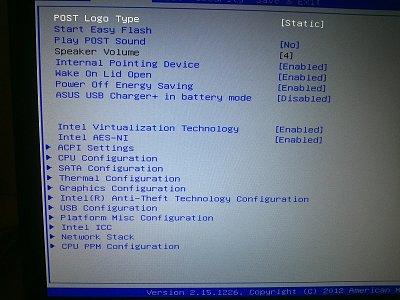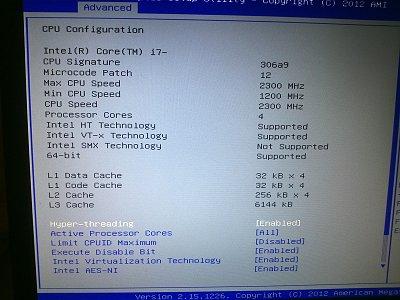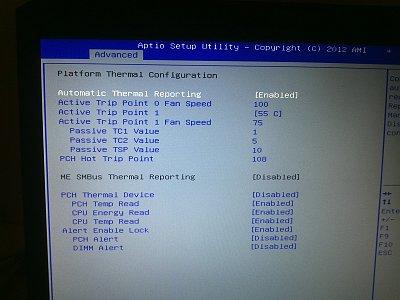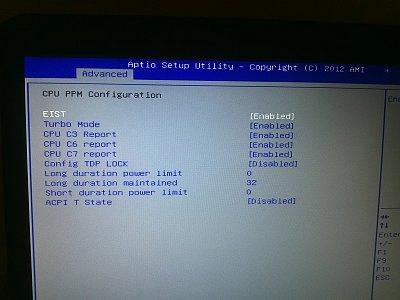Leaderboard
Popular Content
Showing content with the highest reputation on 01/07/13 in all areas
-
Asus G75VW - modified BIOS / VBIOS Here's a modified BIOS for the Asus G75VW. It enables some more options and settings in the BIOS setup. It also contains a tweaked VBIOS for the 660m. Detailed version information: mod02 'GHZ edition' - 660m 3d clocks at 1000MHz core - 670m @ 715/1650 (only in 'overclock edition') additional BIOS menus Pics of the most interesting BIOS settings (thanks @bobby7): Instructions: Download the BIOS you want to flash, as well as the flash tool (Win64). Put the modified BIOS (and included files) in the same folder as the flash tool . Make sure that your current BIOS version is the same as the one you want to flash. Then create a backup of your BIOS by executing the backup.bat file. . Download the 'G75VW-BiosFixer.zip, put it in the same folder as the flash too and run it. Follow the instructions on the screen, it will ask you for the BIOS backup you just created, as well as the modified BIOS file which you already downloaded. . If the tool doesn't come up with an error message, go ahead and flash the created file by executing the included flash.bat file. . Wait until the flashing is done, in case everything's okay you can reboot. NOTE: It's a good idea to go to load the default BIOS settings after flashing. Also I really recommend flashing the official version before applying the modified BIOS, as mentioned in the instructions. >>> Here's my donation link, if you like my mods feel free to buy me a beer <<< As always with such mods, use at your own risk. The program I provide here (BiosFixer) comes with absolutely no warranty to the extent permitted by applicable law. *** Asus G75VW - BIOS v223 - [unlocked] [overclock edition].zip G75VW-BiosFixer.zip Asus G75VW - BIOS v223 - [unlocked].zip1 point
-
*** User with any of the M14x R2 / M17x R4 / M18x R2 notebooks with a current BIOS have reported issues when using the Secure Boot / Fast Boot options in combination with the dedicated Nvidia / AMD GPU.("Can't detect MXM card GOP driver" in case of the R4 / M18x R2) The reason for this is simple - Dell never provided a vbios update which includes the necessary graphic drivers to make those feature work. The only UEFI compliant drivers in the system have been the ones of the Intel HD iGP. A very big failure on Dell's side if you ask me, especially since this has been reported here and in other forums as well on the dell community site and it was said that people would look into this... absolutely nothing happened.Not that this really surprises me... looking at the latest BIOS releases and also at the behavior regarding release notes for such updates. Seems we need to look for the updates ourselves. Anyway, Dell actually ships the very latest systems with updated vbios on the dedicated GPUs. Attached to this post you can find a new vbios for the Nvidia GTX 680m, 660m as well as the AMD 7970m. Both include the required UEFI drivers, and should therefor fix this issue. Thanks @Zyron for the 680m vbios. I don't have a version for the 675m so far, so if anyone has an updated vbios for that card, please let me know or post it. Flashing instructions for Nvidia: http://forum.techinferno.com/general-notebook-discussions/2166-%5Bguide%5D-nvidia-vbios-flashing.html Flashing instructions for AMD: http://forum.techinferno.com/general-notebook-discussions/1738-%5Bguide%5D-amd-vbios-flashing.html As for the M14x R2, a new, yet unreleased BIOS (A10) has made it's way to the web. You can find it here: http://forum.techinferno.com/alienware-m14x/2655-%5Bm14x-r2%5D-a10-bios-fixes-uefi-issues-nvidia-card.html Check the third post. Also I took a quick look at it and wrote down the most important changes (post #4). EDIT: M14x R2 BIOS A10 is now officially available on the Dell drivers site. *** M14x R2-Dell GTX 660m - 80.07.39.00.0F.zip M14x R2-Dell GTX 680m - 80.04.5B.00.02.zip M14x R2-Dell 7970m - 015.022.000.001.000000.C42904A1.119.zip M14x R2-Dell 675m - 70.24.4E.00.10.zip M17x R4-Dell GTX 660m - 80.07.39.00.0F.zip M17x R4-Dell GTX 680m - 80.04.5B.00.02.zip M17x R4-Dell 7970m - 015.022.000.001.000000.C42904A1.119.zip M17x R4-Dell 675m - 70.24.4E.00.10.zip M18x R2-Dell GTX 660m - 80.07.39.00.0F.zip M18x R2-Dell GTX 680m - 80.04.5B.00.02.zip M18x R2-Dell 7970m - 015.022.000.001.000000.C42904A1.119.zip M18x R2-Dell 675m - 70.24.4E.00.10.zip1 point
-
[Desktop & Mobile] NVIDIA Geforce 310.90 WHQL New in GeForce 310.90: --> Adds a security update for the NVIDIA Display Driver service (nvvsvc.exe). Improves performance for GeForce GTX 690: Up to 19% faster performance in Autodesk 3ds Max when interacting with large models compared to GeForce GTX 480. Up to 60% faster performance in ray tracing applications such as NVIDIA iray and Chaos V-Ray (subject to the scene fitting into graphics memory) compared to GeForce GTX 480. Up to 76% faster performance in the 3D extruded ray tracing capability in Adobe After Effects compared to GeForce GTX 480. Updates SLI profiles for Far Cry 3 and NBA2k13. Adds new 3D Vision profiles for the following games: Aliens: Colonial Marines – rated Fair GT Legends – rated 3D Vision Ready LEGO: Lord of the Rings – rated Good Miasmata – rated Good Pirate101 – rated 3D Vision Ready Viking: Battle for Asgard – rated Excellent Warframe – rated Good Wizard101 – rated 3D Vision Ready Changelog R310: Download: Geforce.com1 point
-
This is just a follow up to my own post that may be useful to someone else. I managed to purchase a Killer Wireless-N 1202 (Part No: CTJ7G) from Dell and replaced the AzureWave WB225 that came with the GX60. The AzureWave card that came with the GX60 does not support 5GHz A/N WiFi frequencies and could only use the 2.4 GHz frequencies on my dual-band router. I wanted a dual-band WiFi card to avoid interference from the many 2.4GHz routers near my apartment by using the 5GHz band and when I am out with the commonly available 2.4GHz routers out there. While the card is from Dell, it works perfectly with the stock drivers from Killer themselves. I would recommend using the stock drivers as they are the latest and have the best compatibility with most routers. The WiFi and BT Fn keys work fine with this card as well. The S-Bar utility works with it too. No hacks required to get all of these features to work. Before installing the new Killer card, I downloaded the Windows drivers from KillerGaming and I uninstalled all drivers related to the AzureWave, even including the Bluetooth drivers. Based on a tip from Meaker, I found the AzureWave card under the power button panel (the one above the keyboard with the speaker holes on it). When removing the panel, be extra careful not to use too much force. The ribbon cable under it might snap. To remove the panel, remove the cooling fan and push the plastic clips underneath it out. You can also remove the DVD drive to unveil a clip for the other end of the panel to push out. This will make it easier to snap it off without damaging it or the ribbon cable. You should then see two antenna connected to a tiny mPCIe module that was covered by the power button panel. To remove the module, unplug the antenna cables and unscrew the single screw holding the module down. Once you remove the screw, the module should pop-up and you can replace it with another compatible one without any force. Insert the replacement module and screw it down before plugging in the antennas. Make sure to plug the antennas in the same position as the original card or your WiFi just won't work. The Killer card I used had specific markings on where the black and grey antenna plugs should go. If your replacement module has this information, please follow that instead. Once you've done putting everything back together, you should be able to boot up your system and log into Windows and install the drivers you've downloaded earlier. After you reboot your system, you should be able to see all WiFi access points after logging into Windows. That is all there is to it. However, if you run into issues, you may want to take your laptop over to a friend and try connecting to their WiFi to isolate whether your card is faulty or incompatible with your WiFi router. For example, I could not connect to my Asus RT-N66U but it worked fine with my Apple Time Capsule and a Nokia N9 HotSpot. After setting the WiFi radio region codes on my Asus router, it worked flawlessly. I have not tried this with any other WiFi card. However, based on information from Meaker, the ones based on Atheros chipsets should work fine. The Killer 1202 card I installed uses Atheros chips for both WiFi and BT.1 point
-
Added BIOS v221 660m / 670m combo mod with fixed keyboard light to the first post.1 point
-
The vbios was compiled in August... yeah, it takes a while.1 point
-
Oh yes, I see a lot I also see all the guys on that forum who re-host my bios mods, remove the "read me" file I included and give no link to the source or credits at all... I didn't notice a big difference between 306 and 310 driver when it comes to benchmarking. 1292MHz is very high for that chip. Do yo have a 3dM11 link for that result?1 point
-
@svl7 I have just read from page 1 all the way to this very last page, I can tell you what and that is that my head hurts! So much information going on! Yourself, John, fox etc are gods! I'm planning on flashing to the dell 680m vbios (own an M17xR4 now) in your very first post to see how that goes. I'm going to donate to you bosses because this place is truly awesome. Keep up this damn good work! might I just ask, if one was to flash to a dell 680m vbios, would you recommend the bios from your very first post, OR one of the experimental OV ones from your second post? I would be chasing P8000. I do understand that every cards different so I may not be able to achieve this however would love to give it a red hot go! If unsure I may just flash them all!1 point
-
nvflash -6 is all you need. All flashing details can be found here: http://forum.techinferno.com/general-notebook-discussions/2166-%5Bguide%5D-nvidia-vbios-flashing.html The OCedition revised is at stock clocks, but you can easily overclock it by using nvidia inspector or similar. The best would probably be a modified version of your MSI vbios, which I haven't done yet. Will do so when I find time.1 point








